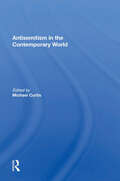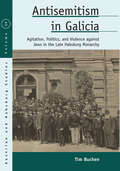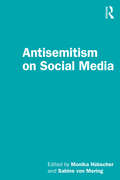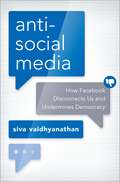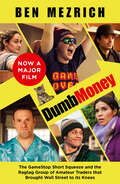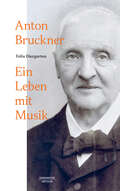- Table View
- List View
Antisemitism and the left: On the return of the Jewish question
by Robert Fine Philip SpencerA highly original conceptual study of the opposing faces of universalism, its stimulation for Jewish emancipation and the struggle for its rescue from repressive, antisemitic associations.
Antisemitism in America
by Leonard DinnersteinIs antisemitism on the rise in America? Did the "hymietown" comment by Jesse Jackson and the Crown Heights riot signal a resurgence of antisemitism among blacks? The surprising answer to both questions, according to Leonard Dinnerstein, is no--Jews have never been more at home in America. But what we are seeing today, he writes, are the well-publicized results of a long tradition of prejudice, suspicion, and hatred against Jews--the direct product of the Christian teachings underlying so much of America's national heritage. In Antisemitism in America, Leonard Dinnerstein provides a landmark work--the first comprehensive history of prejudice against Jews in the United States, from colonial times to the present. His richly documented book traces American antisemitism from its roots in the dawn of the Christian era and arrival of the first European settlers, to its peak during World War II and its present day permutations--with separate chapters on antisemititsm in the South and among African-Americans, showing that prejudice among both whites and blacks flowed from the same stream of Southern evangelical Christianity. He shows, for example, that non-Christians were excluded from voting (in Rhode Island until 1842, North Carolina until 1868, and in New Hampshire until 1877), and demonstrates how the Civil War brought a new wave of antisemitism as both sides assumed that Jews supported with the enemy. We see how the decades that followed marked the emergence of a full-fledged antisemitic society, as Christian Americans excluded Jews from their social circles, and how antisemetic fervor climbed higher after the turn of the century, accelerated by eugenicists, fear of Bolshevism, the publications of Henry Ford, and the Depression. Dinnerstein goes on to explain that just before our entry into World War II, antisemitism reached a climax, as Father Coughlin attacked Jews over the airwaves (with the support of much of the Catholic clergy) and Charles Lindbergh delivered an openly antisemitic speech to an isolationist meeting. After the war, Dinnerstein tells us, with fresh economic opportunities and increased activities by civil rights advocates, antisemititsm went into sharp decline--though it frequently appeared in shockingly high places, including statements by Nixon and his Chairman of the Joint Chiefs of Staff. "It must also be emphasized," Dinnerstein writes, "that in no Christian country has antisemitism been weaker than it has been in the United States," with its traditions of tolerance, diversity, and a secular national government. This book, however, reveals in disturbing detail the resilience, and vehemence, of this ugly prejudice. Penetrating, authoritative, and frequently alarming, this is the definitive account of a plague that refuses to go away.
Antisemitism In The Contemporary World
by Michael CurtisOriginal essays by various scholars on the questions of whether there are new forms of antisemitism, whether there has been a resurgence of antisemitism in the current age, and whether critical attitudes towards Zionism or opposition to the State of Israel and its policies have given new impetus to antisemitism. The contributors also examine the complex relationship between the State of Israel and the Jewish community worldwide
Antisemitism In The Contemporary World
by Michael CurtisOriginal essays by various scholars on the questions of whether there are new forms of antisemitism, whether there has been a resurgence of antisemitism in the current age, and whether critical attitudes towards Zionism or opposition to the State of Israel and its policies have given new impetus to antisemitism. The contributors also examine the complex relationship between the State of Israel and the Jewish community worldwide
Antisemitism in Galicia: Agitation, Politics, and Violence against Jews in the Late Habsburg Monarchy (Austrian and Habsburg Studies #29)
by Tim BuchenIn the last third of the nineteenth century, the discourse on the “Jewish question” in the Habsburg crownlands of Galicia changed fundamentally, as clerical and populist politicians emerged to denounce the Jewish assimilation and citizenship. This pioneering study investigates the interaction of agitation, violence, and politics against Jews on the periphery of the Danube monarchy. In its comprehensive analysis of the functions and limitations of propaganda, rumors, and mass media, it shows just how significant antisemitism was to the politics of coexistence among Christians and Jews on the eve of the Great War.
Antisemitism in Galicia: Agitation, Politics, and Violence against Jews in the Late Habsburg Monarchy (Austrian and Habsburg Studies #29)
by Tim BuchenIn the last third of the nineteenth century, the discourse on the “Jewish question” in the Habsburg crownlands of Galicia changed fundamentally, as clerical and populist politicians emerged to denounce the Jewish assimilation and citizenship. This pioneering study investigates the interaction of agitation, violence, and politics against Jews on the periphery of the Danube monarchy. In its comprehensive analysis of the functions and limitations of propaganda, rumors, and mass media, it shows just how significant antisemitism was to the politics of coexistence among Christians and Jews on the eve of the Great War.
Antisemitism in Galicia: Agitation, Politics, and Violence against Jews in the Late Habsburg Monarchy (Austrian and Habsburg Studies #29)
by Tim BuchenIn the last third of the nineteenth century, the discourse on the “Jewish question” in the Habsburg crownlands of Galicia changed fundamentally, as clerical and populist politicians emerged to denounce the Jewish assimilation and citizenship. This pioneering study investigates the interaction of agitation, violence, and politics against Jews on the periphery of the Danube monarchy. In its comprehensive analysis of the functions and limitations of propaganda, rumors, and mass media, it shows just how significant antisemitism was to the politics of coexistence among Christians and Jews on the eve of the Great War.
Antisemitism in Reader Comments: Analogies for Reckoning with the Past (Postdisciplinary Studies in Discourse)
by Matthias J. BeckerThis book examines the most frequent form of Jew-hatred: Israel-related antisemitism. After defining this hate ideology in its various manifestations and the role the internet plays in it, the author explores the question of how Israel-related antisemitism is communicated and understood through the language used by readers in below-the-line comments. Drawing on a corpus of over 6,000 comments from traditionally left-wing news outlets The Guardian and Die Zeit, the author examines both implicit and explicit comparisons made between modern-day Israel and both colonial Britain and Nazi Germany. His analyses are placed within the context of resurgent neo-nationalism in both countries, and it is argued that these instances of antisemitism perform a multi-faceted role in absolving guilt, re-writing history, and reinforcing in-group status. This book will be of interest not only to linguistics scholars, but also to academics in fields such as internet studies, Jewish studies, hate speech and antisemitism.
Antisemitism on Social Media
by Monika Hübscher Sabine Von MeringAntisemitism on Social Media is a book for all who want to understand this phenomenon. Researchers interested in the matter will find innovative methodologies (CrowdTangle or Voyant Tools mixed with discourse analysis) and new concepts (tertiary antisemitism, antisemitic escalation) that should become standard in research on antisemitism on social media. It is also an invitation to students and up-and-coming and established scholars to study this phenomenon further. This interdisciplinary volume addresses how social media with its technology and business model has revolutionized the dissemination of antisemitism and how this impacts not only victims of antisemitic hate speech but also society at large. The book gives insight into case studies on different platforms such as Twitter, Facebook, TikTok, YouTube, and Telegram. It also demonstrates how social media is weaponized through the dissemination of antisemitic content by political actors from the right, the left, and the extreme fringe, and critically assesses existing counter-strategies. People working for social media companies, policy makers, practitioners, and journalists will benefit from the questions raised, the findings, and the recommendations. Educators who teach courses on antisemitism, hate speech, extremism, conspiracies, and Holocaust denial but also those who teach future leaders in computer technology will find this volume an important resource.
Antisemitism on Social Media
by Monika Hübscher and Sabine von MeringAntisemitism on Social Media is a book for all who want to understand this phenomenon. Researchers interested in the matter will find innovative methodologies (CrowdTangle or Voyant Tools mixed with discourse analysis) and new concepts (tertiary antisemitism, antisemitic escalation) that should become standard in research on antisemitism on social media. It is also an invitation to students and up-and-coming and established scholars to study this phenomenon further. This interdisciplinary volume addresses how social media with its technology and business model has revolutionized the dissemination of antisemitism and how this impacts not only victims of antisemitic hate speech but also society at large. The book gives insight into case studies on different platforms such as Twitter, Facebook, TikTok, YouTube, and Telegram. It also demonstrates how social media is weaponized through the dissemination of antisemitic content by political actors from the right, the left, and the extreme fringe, and critically assesses existing counter-strategies. People working for social media companies, policy makers, practitioners, and journalists will benefit from the questions raised, the findings, and the recommendations. Educators who teach courses on antisemitism, hate speech, extremism, conspiracies, and Holocaust denial but also those who teach future leaders in computer technology will find this volume an important resource.
Antisemitismus in der Bundesrepublik Deutschland: Ergebnisse der empirischen Forschung von 1946–1989
by Werner Bergmann Rainer ErbAntisemitismus in der deutschen Geschichte (Beiträge zur Politik und Zeitgeschichte)
by Armin Pfahl-TraughberDiese Darstellung entlang der historischen Entwicklung fragt danach, inwieweit von einer ständigen Präsenz des Antisemitismus in Deutschland gesprochen werden kann und in welcher Form er sich ggf. bezogen auf Inhalte und Zielsetzungen äußerte.
Antisemitismus und Recht: Interdisziplinäre Annäherungen
by Christoph SchuchWas heißt es, über Antisemitismus und Recht nachzudenken? Aus interdisziplinärer Perspektive betrachten die Beiträger*innen erstmals die Zusammenhänge dieses Forschungsfelds. Zugänge aus unterschiedlichen Disziplinen wie unter anderem der Geschichtswissenschaft, Philosophie, Soziologie, Literaturwissenschaft und Rechtswissenschaft schließen erste Lücken, zeigen aber auch Probleme, Herausforderungen und Desiderate auf. Der Band schafft somit nicht zuletzt Grundlagen für ein verstärktes Wissen im Hinblick auf Antisemitismus in Rechtswissenschaft und -praxis.
Antisemitismus unter ,,muslimischen Jugendlichen": Empirische Perspektiven auf Antisemitismus im Zusammenhang mit Religiösem im Denken und Wahrnehmen Jugendlicher
by Stefan E. HößlIn seiner empirisch fundierten Studie untersucht Stefan E. Hößl Zusammenhänge zwischen Antisemitismus und Religiösem bei Jugendlichen, die sich als Musliminnen und Muslime definieren. Der Autor lässt eine rekonstruktive Analysehaltung zum Tragen kommen und fragt dabei, inwiefern Religiöses – fernab einer bloßen religiösen Selbstverortung der Jugendlichen – in ihrem Denken und Wahrnehmen einen Niederschlag findet. Auf der Basis der Auswertung qualitativ-narrativer und Leitfaden-Interviews arbeitet er zwei kontrastierende Konstellationen heraus. Aus seinen Ergebnissen leitet der Autor Reflexionen für die antisemitismuskritische Bildungsarbeit ab.
Antislavery Discourse and Nineteenth-Century American Literature: Incendiary Pictures
by J. HusbandAntislavery Discourse and Nineteenth-Century American Literature examines the relationship between antislavery texts and emerging representations of "free labor" in mid-nineteenth-century America. Husband shows how the images of families split apart by slavery, circulated primarily by women leaders, proved to be the most powerful weapon in the antislavery cultural campaign and ultimately turned the nation against slavery. She also reveals the ways in which the sentimental narratives and icons that constituted the "family protection campaign" powerfully influenced Americans sense of the role of government, gender, and race in industrializing America. Chapters examine the writings of ardent abolitionists such as Frederick Douglass, non-activist sympathizers, and those actively hostile to but deeply immersed in antislavery activism including Nathaniel Hawthorne.
Antisocial Media: How Facebook Disconnects Us and Undermines Democracy
by Siva VaidhyanathanA fully updated paperback edition that includes coverage of the key developments of the past two years, including the political controversies that swirled around Facebook with increasing intensity in the Trump era. If you wanted to build a machine that would distribute propaganda to millions of people, distract them from important issues, energize hatred and bigotry, erode social trust, undermine respectable journalism, foster doubts about science, and engage in massive surveillance all at once, you would make something a lot like Facebook. Of course, none of that was part of the plan. In this fully updated paperback edition of Antisocial Media, including a new chapter on the increasing recognition of--and reaction against--Facebook's power in the last couple of years, Siva Vaidhyanathan explains how Facebook devolved from an innocent social site hacked together by Harvard students into a force that, while it may make personal life just a little more pleasurable, makes democracy a lot more challenging. It's an account of the hubris of good intentions, a missionary spirit, and an ideology that sees computer code as the universal solvent for all human problems. And it's an indictment of how "social media" has fostered the deterioration of democratic culture around the world, from facilitating Russian meddling in support of Trump's election to the exploitation of the platform by murderous authoritarians in Burma and the Philippines. Both authoritative and trenchant, Antisocial Media shows how Facebook's mission went so wrong.
Antisocial Media: How Facebook Disconnects Us and Undermines Democracy
by Siva VaidhyanathanA fully updated paperback edition that includes coverage of the key developments of the past two years, including the political controversies that swirled around Facebook with increasing intensity in the Trump era. If you wanted to build a machine that would distribute propaganda to millions of people, distract them from important issues, energize hatred and bigotry, erode social trust, undermine respectable journalism, foster doubts about science, and engage in massive surveillance all at once, you would make something a lot like Facebook. Of course, none of that was part of the plan. In this fully updated paperback edition of Antisocial Media, including a new chapter on the increasing recognition of--and reaction against--Facebook's power in the last couple of years, Siva Vaidhyanathan explains how Facebook devolved from an innocent social site hacked together by Harvard students into a force that, while it may make personal life just a little more pleasurable, makes democracy a lot more challenging. It's an account of the hubris of good intentions, a missionary spirit, and an ideology that sees computer code as the universal solvent for all human problems. And it's an indictment of how "social media" has fostered the deterioration of democratic culture around the world, from facilitating Russian meddling in support of Trump's election to the exploitation of the platform by murderous authoritarians in Burma and the Philippines. Both authoritative and trenchant, Antisocial Media shows how Facebook's mission went so wrong.
Antisocial Media: Crime-watching in the Internet Age
by Mark A. WoodThis book provides a cutting-edge introduction to Internet-facilitated crime-watching and examines how social media have shifted the landscape for producing, distributing, and consuming footage of crime. In this thought-provoking work, Mark Wood examines the phenomenon of antisocial media: participatory online domains where footage of crime is aggregated, sympathetically curated, and consumed as entertainment. Focusing on Facebook pages dedicated to hosting footage of street fights, brawls, and other forms of bareknuckle violence, Wood demonstrates that to properly grapple with antisocial media, we must address not only their content, but also their software. In doing so, this study goes a long way to addressing the fundamental question: how have social media changed the way we consume crime?Synthesizing criminology, media theory, software studies, and digital sociology, Antisocial Media is media criminology for the Facebook age. It is essential reading for students and scholars interested in social media, cultural criminology, and the crime-media interface.
Antisocial Media: Crime-watching in the Internet Age
by Mark A. WoodThis book provides a cutting-edge introduction to Internet-facilitated crime-watching and examines how social media have shifted the landscape for producing, distributing, and consuming footage of crime. In this thought-provoking work, Mark Wood examines the phenomenon of antisocial media: participatory online domains where footage of crime is aggregated, sympathetically curated, and consumed as entertainment. Focusing on Facebook pages dedicated to hosting footage of street fights, brawls, and other forms of bareknuckle violence, Wood demonstrates that to properly grapple with antisocial media, we must address not only their content, but also their software. In doing so, this study goes a long way to addressing the fundamental question: how have social media changed the way we consume crime?Synthesizing criminology, media theory, software studies, and digital sociology, Antisocial Media is media criminology for the Facebook age. It is essential reading for students and scholars interested in social media, cultural criminology, and the crime-media interface.
The Antisocial Network
by Ben MezrichThis is definitive take on the wildest story of the year— the David-vs.-Goliath GameStop short squeeze, a tale of fortunes won and lost overnight that may end up changing Wall Street forever.
Antiterrorist Initiatives (Criminal Justice and Public Safety)
by John B. WolfTraditionally, terrorist bands operating in rural or urban areas use vio lence to cast themselves as a legitimate political force. Necklacing, plac ing an oil-soaked tire around the neck of an informer and then igniting it, and knee-capping, positioning a handgun behind the kneecap of a "tout" (a police informer) and then squeezing the trigger, are among the enforcement methods used by clandestine groups to administer "revo lutionary justice." Necklacing is used by the African National Con gress (A.N.C.). Knee-capping is a traditional Irish Republican Army (I. R. A.) tactic. Governments frequently lend credibility to the terrorists' claim of legitimacy by not implementing measures intended to extirpate them. Frequently, democratic societies fear that rigid control measures pose a threat to civil liberties. Reluctant to move, a democracy is often ham strung by terrorists bent on manipulating its values. A media campaign, intended to mobilize public opinion against the terrorists and garner mass support for the government and its control measures, is the linchpin of any antiterrorist campaign. Centralized intelligence-gathering is another essential component. Terrorism, when it becomes a regular campaign of bombings and other atrocities, is no longer a problem for just the police and the army. The entire society is affected. For example, all groups comprising the multi ethnic popu- vii viii PREFACE tion of Sri Lanka and South Africa are presently exposed to the terror ist threat.
Antiziganismus und Gesellschaft: Soziale Arbeit mit Roma und Sinti aus kritisch-theoretischer Perspektive
by André LohseAndré Lohse untersucht Bedingtheiten, Verhältnisse und Strukturen, die das antiziganistische Ressentiment im gesellschaftlichen Wandel hervorrufen. Er analysiert die Auswirkungen antiziganistischer Konstrukte auf gegenwärtige Machtstrukturen und entschlüsselt kritisch-theoretisch öffentliche Eingriffe in das Leben von Roma und Sinti als apriorische Erziehungsidee. Auf diesem Wege hinterfragt der Autor die noch immer auf Roma und Sinti gerichtete Kontrollorientierung sozialpolitischer Programmatik.
Anton Bruckner: Ein Leben mit Musik
by Felix DiergartenZum 200. Geburtstag von Anton Bruckner legt Felix Diergarten die lang erwartete, grundlegend neu recherchierte Biographie vor. Zugänglich und anschaulich geschrieben, werden alte und neue Bruckner-Bilder anhand der Quellen überprüft. Jedes der 25 chronologisch angeordneten Kapitel beleuchtet eine Lebensphase, eine Begebenheit, einen Ort oder ein besonderes Thema aus Bruckners Leben mit Musik. Das Buch macht so erfahrbar, wie sich Bruckners Kompositionen in seine Lebenswelten fügen: vom oberösterreichischen Dorf in die Metropolen Europas, vom Dorfschulhaus an die Universität, von der Dorfkirche an den neugotischen Dom, von den Dorfmusikanten zu den Wiener Philharmonikern.
The Antonine Wall: The Antonine Wall
by David BreezeAs the most advanced frontier construction of its time, and as definitive evidence of the Romans' time in Scotland, the Antonine Wall is an invaluable and fascinating part of this country's varied and violent history. For a generation, from about AD 140 to 160, the Antonine Wall was the north-west frontier of the Roman Empire. Constructed by the Roman army, it ran from modern Bo'ness on the Forth to Old Kilpatrick on the Clyde and consisted of a turf rampart fronted by a wide and deep ditch.At regular intervals were forts connected by a road, while outside the fort gates clustered civil settlements. Antoninus Pius, whom the wall was named after, reigned longer than any other emperor with the exception of its founder Augustus. Yet relatively little is known about him.In this meticulously researched book, David Breeze examines this enigmatic life and the reasons for the construction and abandonment of his Wall.


